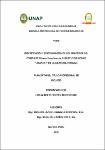| dc.contributor.advisor | Huaranca Acostupa, Richard Javier | |
| dc.contributor.advisor | Ortiz, Rosa del Carmen | |
| dc.contributor.author | Torres Montenegro, Luis Alberto | |
| dc.date.accessioned | 2023-12-13T17:20:47Z | |
| dc.date.available | 2023-12-13T17:20:47Z | |
| dc.date.issued | 2023 | |
| dc.identifier.other | 571.3 T73 2023 | |
| dc.identifier.uri | https://hdl.handle.net/20.500.12737/9604 | |
| dc.description.abstract | This study explores patterns of morphological variation in Minquartia guianensis Aubl. through morphometric analysis of six vegetative characters, with the objective of discriminating four phenotypes that were pre-established based on the type of indument. First, we explored the morphometric and morphological data using a Hierarchical Clustering Analysis (UPGMA) with k=4. Subsequently, we analyzed the six morphometric variables using Principal Components (PCA) and evaluated their relationship, to exclude the one with the highest correlation in further analyses. With the remaining five variables, we performed a Linear Discriminant Analysis (LDA) for the phenotypes and explored to discriminate by soil type and by watershed. Six groups were pre-established for both, for soil type and for watershed . A total of 176 specimens from national and international herbaria and some from field collections were studied. The Glabra and Punctata phenotypes were discriminated effectively, with a success rate of 78.98%. The width of the petiole and the number of secondary veins were the characters that contributed the most to the discrimination of the phenotypes in the first component (LD1=81.9%). The four phenotypes are significantly different (p values <0.01) and the Glabra phenotype is the most distant (R values >0.70) of the four. On the other hand, the percentage of prediction of discrimination by type of soil was 45.14%, while the prediction by watershed only reaches 37.14%. This indicates a low relationship among the specimens of M. guianensis with the type of soil and watershed and does not allow to discriminate the specimens studied. | en_US |
| dc.description.abstract | Este estudio explora patrones de variación morfológica en Minquartia guianensis Aubl. a través de análisis morfométrico de seis caracteres vegetativos, con el objetivo de discriminar cuatro fenotipos que fueron preestablecidos en base al tipo de indumento. En primer lugar, exploramos los datos morfométricos y morfológicos utilizando un Análisis de agrupamiento jerárquico (UPGMA) con k=4. Posteriormente analizamos las seis variables morfométricas usando Componentes Principales (PCA), para excluir el de mayor correlación en análisis posteriores. Con las cinco variables restantes realizamos un análisis Discriminante Lineal (LDA) para los fenotipos y también se exploró discriminarlos por tipo de suelo y cuenca hidrográfica. Para ambos se preestableció 6 grupos por tipo de suelo y 6 por cuenca. Se estudiaron 176 especímenes de herbarios nacionales, internacionales y algunas colectas de campo. Los fenotipos Glabra y Punctata, se discriminaron efectivamente, con un porcentaje de éxito del 78.98%. El ancho del peciolo y el número de venas secundarias fueron los caracteres que más contribuyeron en la discriminación de los fenotipos en el primer componente (LD1=81.9%). Los cuatro fenotipos son significativamente diferentes (valores de p<0.01) y el fenotipo Glabra es el más distante (valores de R>0.70) de los cuatro. Por otro lado, el porcentaje de predicción de discriminación por tipo de suelo fue del 45.14%, mientras que la predicción por cuenca hidrográfica solo alcanza 37.14%. Lo que indica una baja relación entre los especímenes de M. guianensis con el tipo de suelo y cuenca hidrográfica y no permite discriminar a los especímenes estudiados. | es_PE |
| dc.format | application/pdf | es_PE |
| dc.language.iso | spa | es_PE |
| dc.publisher | Universidad Nacional de la Amazonía Peruana | es_PE |
| dc.rights | info:eu-repo/semantics/openAccess | * |
| dc.rights.uri | https://creativecommons.org/licenses/by/4.0/ | * |
| dc.subject | Anatomía de la planta | es_PE |
| dc.subject | Fenotipos | es_PE |
| dc.subject | Minquartia guianensis | es_PE |
| dc.subject | Huacapú | es_PE |
| dc.title | Identificación y discriminación de los fenotipos del complejo Minquartia guianensis Aublet (coulaceae) “huacapú” en la amazonía peruana | es_PE |
| dc.type | info:eu-repo/semantics/bachelorThesis | es_PE |
| thesis.degree.discipline | Ciencias Biológicas | es_PE |
| thesis.degree.grantor | Universidad Nacional de la Amazonía Peruana. Facultad de Ciencias Biológicas | es_PE |
| thesis.degree.name | Biólogo(a) | es_PE |
| dc.subject.ocde | https://purl.org/pe-repo/ocde/ford#1.06.03 | es_PE |
| renati.author.dni | 41433159 | |
| renati.advisor.orcid | https://orcid.org/0000-0002-1640-7679 | |
| renati.advisor.orcid | https://orcid.org/0000-0002-4673-4347 | |
| renati.advisor.dni | 05352981 | |
| renati.advisor.dni | 505768129 | |
| renati.type | https://purl.org/pe-repo/renati/type#tesis | es_PE |
| renati.discipline | 511206 | es_PE |
| renati.level | https://purl.org/pe-repo/renati/level#tituloProfesional | es_PE |
| renati.juror | García Ruiz, Alberto | |
| renati.juror | Grández Ríos, César Augusto | |
| renati.juror | Arévalo García, Meri Nancy | |
| dc.publisher.country | PE | es_PE |





